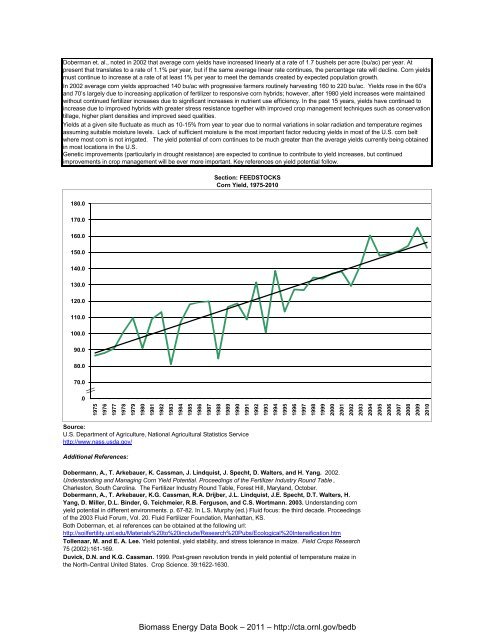Biomass Energy Data Book: Edition 4 - Full Document - Center for ...
Biomass Energy Data Book: Edition 4 - Full Document - Center for ...
Biomass Energy Data Book: Edition 4 - Full Document - Center for ...
Create successful ePaper yourself
Turn your PDF publications into a flip-book with our unique Google optimized e-Paper software.
Doberman et. al., noted in 2002 that average corn yields have increased linearly at a rate of 1.7 bushels per acre (bu/ac) per year. At<br />
present that translates to a rate of 1.1% per year, but if the same average linear rate continues, the percentage rate will decline. Corn yields<br />
must continue to increase at a rate of at least 1% per year to meet the demands created by expected population growth.<br />
In 2002 average corn yields approached 140 bu/ac with progressive farmers routinely harvesting 160 to 220 bu/ac. Yields rose in the 60’s<br />
and 70’s largely due to increasing application of fertilizer to responsive corn hybrids; however, after 1980 yield increases were maintained<br />
without continued fertilizer increases due to significant increases in nutrient use efficiency. In the past 15 years, yields have continued to<br />
increase due to improved hybrids with greater stress resistance together with improved crop management techniques such as conservation<br />
tillage, higher plant densities and improved seed qualities.<br />
Yields at a given site fluctuate as much as 10-15% from year to year due to normal variations in solar radiation and temperature regimes<br />
assuming suitable moisture levels. Lack of sufficient moisture is the most important factor reducing yields in most of the U.S. corn belt<br />
where most corn is not irrigated. The yield potential of corn continues to be much greater than the average yields currently being obtained<br />
in most locations in the U.S.<br />
Genetic improvements (particularly in drought resistance) are expected to continue to contribute to yield increases, but continued<br />
improvements in crop management will be ever more important. Key references on yield potential follow.<br />
180.0<br />
170.0<br />
160.0<br />
150.0<br />
140.0<br />
130.0<br />
120.0<br />
110.0<br />
100.0<br />
90.0<br />
80.0<br />
70.0<br />
60.0<br />
1975<br />
1976<br />
1977<br />
1978<br />
Section: FEEDSTOCKS<br />
Corn Yield, 1975-2010<br />
Source:<br />
U.S. Department of Agriculture, National Agricultural Statistics Service<br />
http://www.nass.usda.gov/<br />
Additional References:<br />
1979<br />
1980<br />
1981<br />
1982<br />
1983<br />
1984<br />
1985<br />
1986<br />
1987<br />
1988<br />
1989<br />
1990<br />
1991<br />
1992<br />
1993<br />
1994<br />
1995<br />
1996<br />
1997<br />
1998<br />
1999<br />
2000<br />
2001<br />
2002<br />
Dobermann, A., T. Arkebauer, K. Cassman, J. Lindquist, J. Specht, D. Walters, and H. Yang. 2002.<br />
Understanding and Managing Corn Yield Potential. Proceedings of the Fertilizer Industry Round Table ,<br />
Charleston, South Carolina. The Fertilizer Industry Round Table, Forest Hill, Maryland, October.<br />
Dobermann, A., T. Arkebauer, K.G. Cassman, R.A. Drijber, J.L. Lindquist, J.E. Specht, D.T. Walters, H.<br />
Yang, D. Miller, D.L. Binder, G. Teichmeier, R.B. Ferguson, and C.S. Wortmann. 2003. Understanding corn<br />
yield potential in different environments. p. 67-82. In L.S. Murphy (ed.) Fluid focus: the third decade. Proceedings<br />
of the 2003 Fluid Forum, Vol. 20. Fluid Fertilizer Foundation, Manhattan, KS.<br />
Both Doberman, et. al references can be obtained at the following url:<br />
http://soilfertility.unl.edu/Materials%20to%20include/Research%20Pubs/Ecological%20Intensification.htm<br />
Tollenaar, M. and E. A. Lee. Yield potential, yield stability, and stress tolerance in maize. Field Crops Research<br />
75 (2002):161-169.<br />
Duvick, D.N. and K.G. Cassman. 1999. Post-green revolution trends in yield potential of temperature maize in<br />
the North-Central United States. Crop Science. 39:1622-1630.<br />
<strong>Biomass</strong> <strong>Energy</strong> <strong>Data</strong> <strong>Book</strong> – 2011 – http://cta.ornl.gov/bedb<br />
2003<br />
2004<br />
2005<br />
2006<br />
2007<br />
2008<br />
2009<br />
2010
















